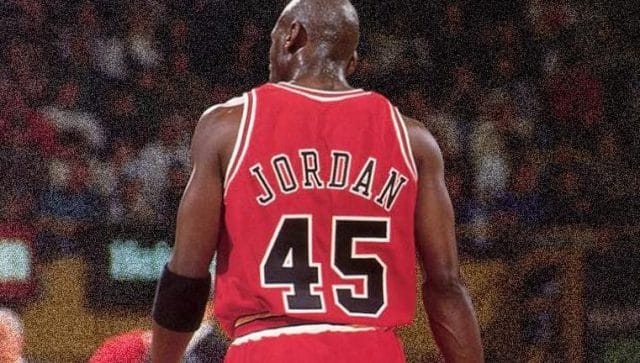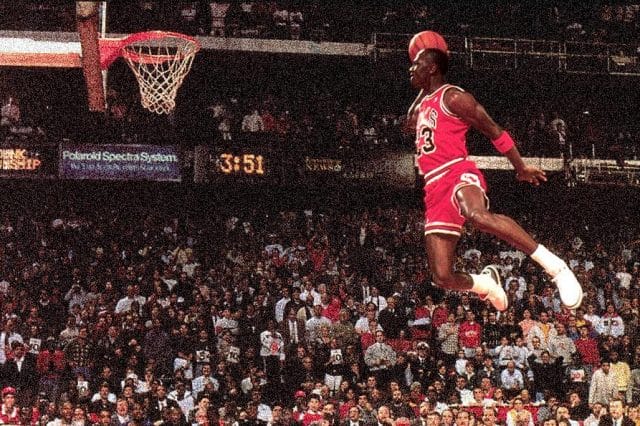When Michael Jordan was in high school, he dreamed of being number 45 — but there was a problem: his older brother Larry, also on the basketball team, had already claimed the digits. So, the young ‘His Airness’ got mathematical.
“He had seniority,” Jordan told the NBA 2K14 team. “He had the option to wear 45, so I just figured 23 was half of 45 — 22-and-a-half. And 23 has just kinda stuck with me the whole time.”
Certainly, it did. In the history of legendary sports numbers — Jackie Robinson’s 42, Wayne Gretzky’s 99, Babe Ruth’s 3 — none has garnered the unanimous recognition of Jordan’s 23. Immortalized on a sea of Nike products, statues, and memorials, number 23 is synonymous with the man who wore it; Bleacher Report calls it “easily the most recognizable number in the sports world.”
But for 22 games during the 1995 season, Michael Jordan was not 23 — he was 45.
Jordan Bids Adieu
In the NBA, Michael Jordan was a force to be reckoned with. Drafted as the number three pick overall by the Chicago Bulls in 1984, he wasted no time establishing himself as not only one of the game’s greatest players, but a cultural icon. His rookie year, he signed his famous shoe endorsement deal with Nike (5 years at $500,000 per year, plus royalties), and was paid $1 million — nearly a quarter of the Bulls’ entire salary cap.
For all involved, Jordan was a lucrative investment: he led the Bulls to three consecutive titles — ‘91, ‘92, and ‘93 — and Nike’s signature Air Jordan sneakers grew to comprise 90% of all shoes in the NBA, earning the company billions of dollars. All the while, the number 23 graced Jordan’s back (though he wore number 12 for one game in 1991, after his jersey was stolen pre-game).
Then, right before the 1993-1994 NBA season, at the apogee of his career, Michael Jordan shocked the sporting world by announcing he’d retire from basketball to play professional baseball. (Earlier that year, Jordan’s father had been brutally murdered; as biographer Sam Smith clarifies, baseball was “something his father always wanted him to do.”)
For nearly a year and half, Jordan cut his teeth in the Chicago White Sox minor league system as number 45 — the digits he’d always wanted in high school. But Jordan’s basketball prowess didn’t translate: he struck out in one out of every four at-bats. By 1995, he was back on the court.
What’s In a Number?
The Bulls had struggled without Jordan during the 1994-95 season; by mid-March, they were 31-31. Then, with a two-word press release — “I’m Back” — Jordan made his glorious return. But when Jordan trotted out on the court on March 19, 1995, it was without his trademark 23 jersey. Upon his return, he’d made it clear that he wouldn’t be wearing number 23 again, since it was the last number his father had seen him play in; the number was immediately retired to Uniter Center’s rafters during a ceremony. This disallowed anyone else in the franchise to wear 23 — including MJ himself.
For 22 games, Jordan played as number 45, but things just weren’t the same. Though he performed well (he scored 19 points in his first game back), many claimed he’d lost some of his mojo; the new jersey number became a scapegoat.
While the Bulls rallied and managed to make it to the 1995 Eastern Conference Semi-finals, Jordan’s number debacle reached a tipping point. With 10 seconds on the clock in game 1, Orlando’s Nick Anderson stole the ball from Jordan — a play that led to the Magic’s game-winning basket. “Number 45 is not number 23,” Anderson told the press after the game. “I couldn’t have done that to number 23.”
In a subsequent AP statement, Jordan agreed. “Number 45 doesn’t explode like Number 23 used to.” He decided he’d had enough: just before tip off for game two (his 23rd game back), Jordan peeled off his warm-up jacket to reveal his old number 23. He’d go on to score 38 points in the game, leading the Bulls to a 104-94 victory.
The NBA was not pleased: the Bulls were fined $25,000 for allowing Jordan to switch numbers, and deputy commissioner Russ Granik pumped out a rather-serious press release:
“We do not think that the issue of jersey numbers should be allowed to become a distraction from the great playoffs that are now under way. The Chicago Bulls have been advised that we will not approve a change in uniform number this season. If the team continues to permit him to appear in a number other than 45, in violation of league policy, the matter will be dealt with in an appropriate manner, at the conclusion of the season.”
‘We can’t have a situation where a player can decide every night what number he wants to wear. Our policy is that you have to apply to the league when you want to change your number and that applies equally to every player in the league.”
Jordan and his management weren’t phased. “He just feels more comfortable in it,” said Bulls vice president Jerry Krause. “It was a response-type thing,” added Phil Jackson, the team’s coach. “He was responding to the comments that he’s not the same old 23. I think that was his response — ‘O.K., check this out’ — that’s my opinion.” Jackson continued:
“Michael said he was hitting .202 with No. 45 on his back in baseball, and I said, ‘You’re shooting about the same percentage, too. It’s about time you get back to 23.’ In respect to the number, it’s all superstitious.”
The next night, Jordan kept his number 23, and the Bulls were once again fined $25,000. Though the Bulls would eventually go on to lose the series, Jordan averaged 31 points per game; by the end of the semi-finals, his refusal to revert to 45 had set the Bulls back $100,000.
Aftermath
During the off-season, the Bulls negotiated with the NBA to give Jordan back number 23. Sporting his old number, he’d lead the bulls to three more championships — ‘96, ‘97, and ‘98 — before retiring in 1999. Bulls owner Jerry Reinsdorf subsequently retired Jordan’s 23 for the second time in five years. “We are returning your number 23 to its rightful place of honor,” he said during the ceremony, “where it will forever serve as a reminder of your dominance on this court and your dominance of this game.” The number was also retired by the Miami Heat — a franchise with whom MJ had no affiliation.
Jordan briefly returned to the NBA with the Washington Wizards — again wearing number 23 — but the stint lasted only two years. In 2003, he bowed out of the NBA for good.
The same year, Lebron James, basketball’s new hot prospect, debuted with the Cleveland Cavaliers wearing number 23. For a number of years, James — a Jordan fanatic — wore the number to honor his hero; in 2009, he changed his mind, and urged the rest of the NBA’s 23’ers to do the same. “If you see 23, you think about Michael Jordan,” he told The Plain Dealer. “I feel like no NBA player should wear 23. I’m starting a petition, and I’ve got to get everyone in the NBA to sign it.” (The “petition” never went anywhere, and a number of NBA players wear 23 today).
After decades of reaping massive profits from its Air Jordan line (nearly $2.3 billion — a coincidence), Nike opened the first “Flight 23” earlier this year in Manhattan. The store features exclusively Jordan-related gear — “the widest assortment available” in the U.S.
All of this isn’t to say that 23 made Jordan; rather, Jordan made 23. As Ex-Orlando Magic coach Brian Hill put it after Jordan’s first $25,000 jersey fine, “The number on the shirt doesn’t mean anything. It’s the basketball player inside the shirt that matters.” And if the player inside the shirt proved anything during his tenure, it’s that he could be any number he damn well pleased.
This post was written by Zachary Crockett. Follow him on Twitter here, or Google Plus here.






